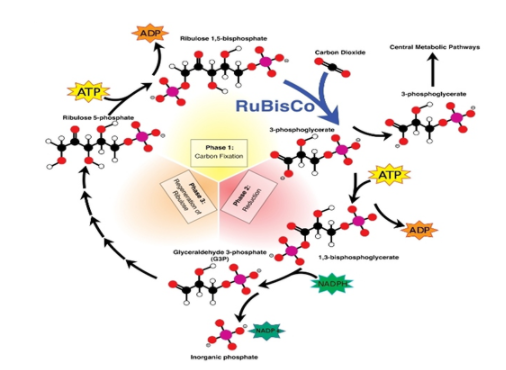
Which of the following is the first stable product of photosynthesis in maize?
A. PGA
B. PGAL
C. PEPA
D. OAA
Answer
555.9k+ views
Hint: Maize belongs to the \[{C_4}\] plant. \[{C_4}\] Plants mainly use the \[{C_4}\] carbon fixation pathway to increase the efficiency of photosynthesis by reducing or inhibiting photorespiration, which occurs mainly at low $C{O_2}$ concentrations in the atmosphere, high light levels, high temperatures, drought and salinity.
Complete answer:
Maize belongs to the \[{C_4}\] Plant. \[{C_4}\] Plants mainly use the \[{C_4}\] Carbon fixation pathway to increase efficiency.
So, for answering let’s look at the \[{C_4}\] cycle.
Along the \[{C_4}\]pathway, atmospheric $C{O_2}$ reaches the mesophyll cells through the pores and binds to phosphoenolpyruvate $\left( {3 - {\text{Carbon}}\,{\text{compound}}} \right)$. This reaction is catalysed by an enzyme known as phosphoenolpyruvate carboxylase PEP Case. The result is the \[{C_4}\] acid, oxaloacetic acid (OAA). This reaction occurs in the cytoplasm of mesophyll cells and is known as $C{O_2}$ fixation or carboxylation.

The next step in the reaction is the transport of oxaloacetic acid $\left( {4 - {\text{Carbon}}\,{\text{compound}}} \right)$ from the cytosol of the mesophilic cell to the chloroplast of the bundle-enveloping cell, where it is decarboxylated to release solid $C{O_2}$ and a high concentration of $C{O_2}$ is generated near Rubisco. Another product of the decarboxylation reaction is a 3 carbon compound called pyruvic acid. These are now transported back to the mesophilic cell.
So, from the above points, it’s clear that the first stable product is oxaloacetic acid.
Hence, the correct answer is option (D).
Note: The photosynthetic system \[{C_4}\] (free hatching pathway) is less efficient than the ${C_3}$ system (Calvin cycle in ${C_3}$ plants). This is because one mole of $C{O_2}$ is fixed. In the ${C_3}$ photosynthesis model, $2\,NADPH$ ,$3\,ATP$ molecules are required, while in the ${C_4}$ photosynthesis model, $2\,NADPH$ , $5ATP$molecules are required to fix one mole of $C{O_2}$. Due to the absence (or insignificant presence) of photorespiration in ${C_4}$. So the net requirement for $ATP - NADPH$ is a mole of $C{O_2}$. Solids content (that is photosynthesis minus photorespiration) was significantly lower in ${C_4}$ plants than in ${C_3}$ plants.
Complete answer:
Maize belongs to the \[{C_4}\] Plant. \[{C_4}\] Plants mainly use the \[{C_4}\] Carbon fixation pathway to increase efficiency.
So, for answering let’s look at the \[{C_4}\] cycle.
Along the \[{C_4}\]pathway, atmospheric $C{O_2}$ reaches the mesophyll cells through the pores and binds to phosphoenolpyruvate $\left( {3 - {\text{Carbon}}\,{\text{compound}}} \right)$. This reaction is catalysed by an enzyme known as phosphoenolpyruvate carboxylase PEP Case. The result is the \[{C_4}\] acid, oxaloacetic acid (OAA). This reaction occurs in the cytoplasm of mesophyll cells and is known as $C{O_2}$ fixation or carboxylation.

The next step in the reaction is the transport of oxaloacetic acid $\left( {4 - {\text{Carbon}}\,{\text{compound}}} \right)$ from the cytosol of the mesophilic cell to the chloroplast of the bundle-enveloping cell, where it is decarboxylated to release solid $C{O_2}$ and a high concentration of $C{O_2}$ is generated near Rubisco. Another product of the decarboxylation reaction is a 3 carbon compound called pyruvic acid. These are now transported back to the mesophilic cell.
So, from the above points, it’s clear that the first stable product is oxaloacetic acid.
Hence, the correct answer is option (D).
Note: The photosynthetic system \[{C_4}\] (free hatching pathway) is less efficient than the ${C_3}$ system (Calvin cycle in ${C_3}$ plants). This is because one mole of $C{O_2}$ is fixed. In the ${C_3}$ photosynthesis model, $2\,NADPH$ ,$3\,ATP$ molecules are required, while in the ${C_4}$ photosynthesis model, $2\,NADPH$ , $5ATP$molecules are required to fix one mole of $C{O_2}$. Due to the absence (or insignificant presence) of photorespiration in ${C_4}$. So the net requirement for $ATP - NADPH$ is a mole of $C{O_2}$. Solids content (that is photosynthesis minus photorespiration) was significantly lower in ${C_4}$ plants than in ${C_3}$ plants.
Recently Updated Pages
Why are manures considered better than fertilizers class 11 biology CBSE

Find the coordinates of the midpoint of the line segment class 11 maths CBSE

Distinguish between static friction limiting friction class 11 physics CBSE

The Chairman of the constituent Assembly was A Jawaharlal class 11 social science CBSE

The first National Commission on Labour NCL submitted class 11 social science CBSE

Number of all subshell of n + l 7 is A 4 B 5 C 6 D class 11 chemistry CBSE

Trending doubts
What is meant by exothermic and endothermic reactions class 11 chemistry CBSE

10 examples of friction in our daily life

One Metric ton is equal to kg A 10000 B 1000 C 100 class 11 physics CBSE

1 Quintal is equal to a 110 kg b 10 kg c 100kg d 1000 class 11 physics CBSE

Difference Between Prokaryotic Cells and Eukaryotic Cells

What are Quantum numbers Explain the quantum number class 11 chemistry CBSE




